FIPRESCI: droplet microfluidics based combinatorial indexing for massive-scale 5'-end single-cell RNA sequencing
- PMID: 37024957
- PMCID: PMC10078054
- DOI: 10.1186/s13059-023-02893-1
FIPRESCI: droplet microfluidics based combinatorial indexing for massive-scale 5'-end single-cell RNA sequencing
Erratum in
-
Publisher Correction: FIPRESCI: droplet microfluidics based combinatorial indexing for massive-scale 5'-end single-cell RNA sequencing.Genome Biol. 2023 Apr 21;24(1):88. doi: 10.1186/s13059-023-02944-7. Genome Biol. 2023. PMID: 37085832 Free PMC article. No abstract available.
Abstract
Single-cell RNA sequencing methods focusing on the 5'-end of transcripts can reveal promoter and enhancer activity and efficiently profile immune receptor repertoire. However, ultra-high-throughput 5'-end single-cell RNA sequencing methods have not been described. We introduce FIPRESCI, 5'-end single-cell combinatorial indexing RNA-Seq, enabling massive sample multiplexing and increasing the throughput of the droplet microfluidics system by over tenfold. We demonstrate FIPRESCI enables the generation of approximately 100,000 single-cell transcriptomes from E10.5 whole mouse embryos in a single-channel experiment, and simultaneous identification of subpopulation differences and T cell receptor signatures of peripheral blood T cells from 12 cancer patients.
Keywords: 10X Genomics; Combinatorial indexing; Sample multiplexing; Single-cell RNA-seq; Single-nucleus RNA-seq; scTCR-seq; scVDJ-seq.
© 2023. The Author(s).
Conflict of interest statement
L. J. and Y.L. are inventors of a patent application describing the FIPRESCI method. The other authors declare that they have no competing interests. The patent does not restrict the use of the method for educational, research, or not-for-profit purposes.
Figures
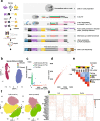
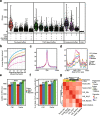
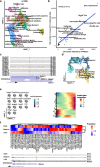
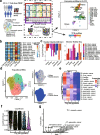
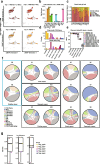
Similar articles
-
Ultra-high-throughput single-cell RNA sequencing and perturbation screening with combinatorial fluidic indexing.Nat Methods. 2021 Jun;18(6):635-642. doi: 10.1038/s41592-021-01153-z. Epub 2021 May 31. Nat Methods. 2021. PMID: 34059827 Free PMC article.
-
UDA-seq: universal droplet microfluidics-based combinatorial indexing for massive-scale multimodal single-cell sequencing.Nat Methods. 2025 Jun;22(6):1199-1212. doi: 10.1038/s41592-024-02586-y. Epub 2025 Jan 20. Nat Methods. 2025. PMID: 39833568 Free PMC article.
-
Comparative Analysis of Droplet-Based Ultra-High-Throughput Single-Cell RNA-Seq Systems.Mol Cell. 2019 Jan 3;73(1):130-142.e5. doi: 10.1016/j.molcel.2018.10.020. Epub 2018 Nov 21. Mol Cell. 2019. PMID: 30472192
-
Single-cell RNA and protein profiling of immune cells from the mouse brain and its border tissues.Nat Protoc. 2022 Oct;17(10):2354-2388. doi: 10.1038/s41596-022-00716-4. Epub 2022 Aug 5. Nat Protoc. 2022. PMID: 35931780 Review.
-
Microfluidics Facilitates the Development of Single-Cell RNA Sequencing.Biosensors (Basel). 2022 Jun 24;12(7):450. doi: 10.3390/bios12070450. Biosensors (Basel). 2022. PMID: 35884253 Free PMC article. Review.
Cited by
-
Transcriptome and Temporal Transcriptome Analyses in Single Cells.Int J Mol Sci. 2024 Nov 29;25(23):12845. doi: 10.3390/ijms252312845. Int J Mol Sci. 2024. PMID: 39684556 Free PMC article. Review.
-
Functional genomics in inborn errors of immunity.Immunol Rev. 2024 Mar;322(1):53-70. doi: 10.1111/imr.13309. Epub 2024 Feb 8. Immunol Rev. 2024. PMID: 38329267 Free PMC article. Review.
-
Advancements and applications of single-cell multi-omics techniques in cancer research: Unveiling heterogeneity and paving the way for precision therapeutics.Biochem Biophys Rep. 2023 Nov 29;37:101589. doi: 10.1016/j.bbrep.2023.101589. eCollection 2024 Mar. Biochem Biophys Rep. 2023. PMID: 38074997 Free PMC article. Review.
-
The heterogeneity of erythroid cells: insight at the single-cell transcriptome level.Cell Tissue Res. 2024 Sep;397(3):179-192. doi: 10.1007/s00441-024-03903-9. Epub 2024 Jul 2. Cell Tissue Res. 2024. PMID: 38953986 Review.
-
Advances and applications in single-cell and spatial genomics.Sci China Life Sci. 2025 May;68(5):1226-1282. doi: 10.1007/s11427-024-2770-x. Epub 2024 Dec 20. Sci China Life Sci. 2025. PMID: 39792333 Review.
References
Publication types
MeSH terms
Substances
LinkOut - more resources
Full Text Sources
Other Literature Sources
Molecular Biology Databases

